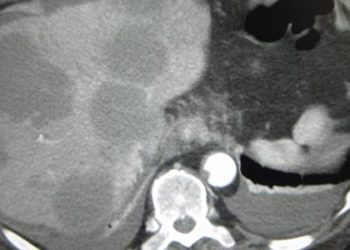Noninvasive imaging method detects and evaluates size of metastases
1. Dually injecting mice featuring lymph node cancer metastases with a non-targeted fluorescent antibody (noTRGT) and a cancer-targeted fluorescent antibody (TRGT) allowed for determination of cancer-receptor concentrations in the lymph nodes.
2. The calculated concentrations of the cancer-receptor strongly correlated with the number of tumor cells in a given tumor, thus providing a clear readout of metastasis size.
Evidence Rating Level: 2 (Good)
Study Rundown: Clinicians often use a lymph node biopsy to determine if the primary tumor has metastasized, and if so, to what degree. Such biopsies require time-consuming histological analysis, and may cause significant injury or discomfort to the patient. Alternative non-invasive methods of metastasis evaluation measure injected TRGT signal distributions. This method is limited in success, presumably because non-specific, flow-dependent uptake of the TRGT causes poor correlation between TRGT signal and tumor presence.
Here, researchers attempted to improve diagnostic capabilities of lymph node tumor imaging through dual injection of both TRGT and noTRGT tracers in mice with lymph node metastases. In this study the TRGT was an antibody specific to epidermal growth factor receptor (EGFR), which is overexpressed by tumor cells, and the noTRGT was an untargeted antibody. By comparing the fluorescent signals of the two tracers, the authors calculated the EGFR concentration in a given lymph node. This EGFR concentration was closely correlated with the number of tumor cells in the node for metastases larger than 200 cells, thus demonstrating a sensitivity level which may exceed that of histological analysis currently used for biopsies. Larger animal studies of different tumor types, advances in imaging techniques to increase depth of fluorescence readings, and a better understanding of targetable cancer receptors may all be necessary before this method becomes applicable to human patients. This exciting work suggests a quicker, less invasive, and more sensitive method to assess tumor metastases may be near at hand.
Click to read the study in Nature Medicine
Relevant Reading: Dynamic dual-tracer MRI-guided fluorescence tomography to quantify receptor density in vivo
In-Depth [animal study]: A total of 22 nude mice were used in this study, with 4 serving as controls, and 18 injected with human breast cancer cells at age 6-8 weeks. Six weeks later, primary tumors, if present, were removed, and left and right lymph nodes were imaged ~12 weeks later (36 nodes with tumors, 8 healthy nodes). For metastasis detection, researchers simultaneously injected the mice with TRGT and noTRGT. The two tracers had different excitation wavelengths, to allow separate analysis of the tracer distributions. Simultaneous imaging of the TRGT and noTRGT and comparison of the resulting fluorescence readings allowed the authors to mathematically derive an EGFR concentration for a given lymph node. Following 3 hours of imaging, mice were sacrificed and lymph nodes were excised. Quantitative real-time polymerase chain reaction (qPCR) determination of tumor cell number in the nodes was highly correlated with the EGFR concentrations calculated from images collected 3 hrs after initial tracer injection (r = 0.97, p<0.01). Categorizing lymph node tumors into groups of control, <200 cells, and >200 cells, as determined by qPCR, lymph nodes with >200 cells had higher EGFR concentration than the other two groups (p<0.05). No difference was found between the targeted and untargeted take up in control lymph nodes.
More from this author: Inhibition of key enzymes in the animal brain reduces drug relapse behavior
Image: CC/Wiki/Nephron
©2012-2014 2minutemedicine.com. All rights reserved. No works may be reproduced without expressed written consent from 2minutemedicine.com. Disclaimer: We present factual information directly from peer reviewed medical journals. No post should be construed as medical advice and is not intended as such by the authors, editors, staff or by 2minutemedicine.com. PLEASE SEE A HEALTHCARE PROVIDER IN YOUR AREA IF YOU SEEK MEDICAL ADVICE OF ANY SORT.


![ABCD2 Score: Predicting Early Stroke Risk After Transient Ischemic Attack (TIA) [Classics Series]](https://www.2minutemedicine.com/wp-content/uploads/2013/05/web-cover-classics-with-logo-medicine-BW-small-jpg-350x250.jpg)






